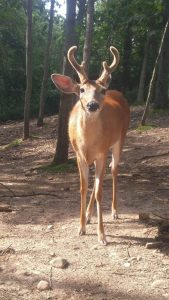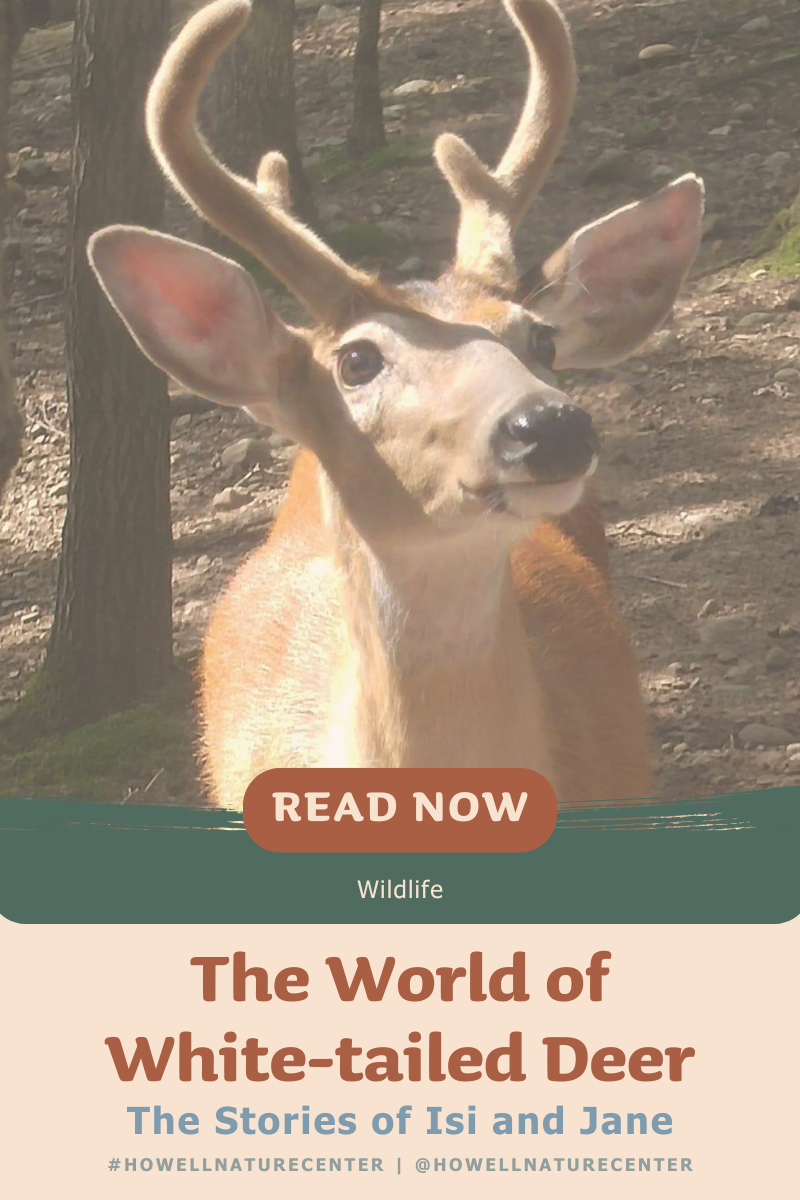Welcome to a closer look into the lives of two special residents at the Howell Nature Center, Isi and Jane, our resident white-tailed deer. Their unique circumstances provide an excellent opportunity to explore the biology, behavior, and conservation needs of one of Michigan’s most iconic wildlife species.
Meet Isi and Jane: Unique Stories of Adaptation
 Isi: The Gentle Stag
Isi: The Gentle Stag
- Identification: Isi can be recognized by his antlers, which he grows and sheds annually, a fascinating aspect of deer biology that reflects their health and age.
- Background: Born in 2013, Isi required specialized care as a fawn and became acclimated to human presence, making him unsuitable for release into the wild.
- Habitat Preferences: Isi enjoys the serene environment at the base of an oak tree or finds comfort within the sheltered sheds, especially during inclement weather.
Jane: The Doe with a Domestic Past
- Identification: Jane is smaller than Isi, with a delicate frame and the absence of antlers, typical of female white-tailed deer.
- Background: Born in 2022, Jane’s early life was marked by being kept illegally as a pet, leading to her habituation to humans and necessitating her care at the nature center.
- Habitat Preferences: Like Isi, Jane can often be found grazing near the oak tree’s base or seeking refuge in the sheds during colder temperatures.
Understanding White-tailed Deer: Biology and Ecology
White-tailed deer are fascinating creatures, and by learning about their biology and ecology, we can appreciate their role in Michigan’s ecosystems.
Anatomy and Physiology: White-tailed deer are ruminants, meaning they have a four-chambered stomach that allows them to efficiently process a wide variety of plant materials. This digestive adaptation is crucial for their survival across the changing seasons.
Antler Growth: Antlers are a remarkable feature of male white-tailed deer, like Isi. These structures are made of bone and are shed and regrown annually, influenced by factors such as daylight, nutrition, and the deer’s overall health.
Behavior: Typically crepuscular, white-tailed deer are most active during dawn and dusk. However, their activity levels can vary, and they may be active at any time, depending on environmental conditions and human activity levels.
Habitats and Diets: Adapting to Seasons
White-tailed deer are highly adaptable, thriving in a variety of habitats from farmlands to forest edges and even suburban areas. Their diets change with the seasons:
- Summer: They feed on a plethora of green plants, taking advantage of the abundance of foliage.
- Fall: Their diet shifts to nuts, acorns, and corn, providing the fat reserves necessary for winter.
- Winter: Deer rely on twigs, conifers, and other woody vegetation, showcasing their ability to survive even in harsh conditions.
Conservation and Coexistence
Once nearly exterminated in the Midwest due to overhunting and habitat loss, white-tailed deer populations have rebounded thanks to wildlife management practices and the absence of large predators like wolves. This resurgence highlights the importance of balanced ecosystems and the role of conservation in maintaining wildlife populations.
Engaging with White-tailed Deer: A Nature Center’s Role
At the Howell Nature Center, Isi and Jane serve as ambassadors for their species, providing visitors with a unique opportunity to learn about and appreciate white-tailed deer up close. By understanding their stories and the broader context of deer biology and conservation, we can foster a deeper connection with Michigan’s natural heritage and the diverse wildlife that calls it home.
In exploring the world of Isi and Jane, we’re reminded of the resilience of nature and the importance of each individual in telling the broader story of wildlife conservation and ecological balance.


